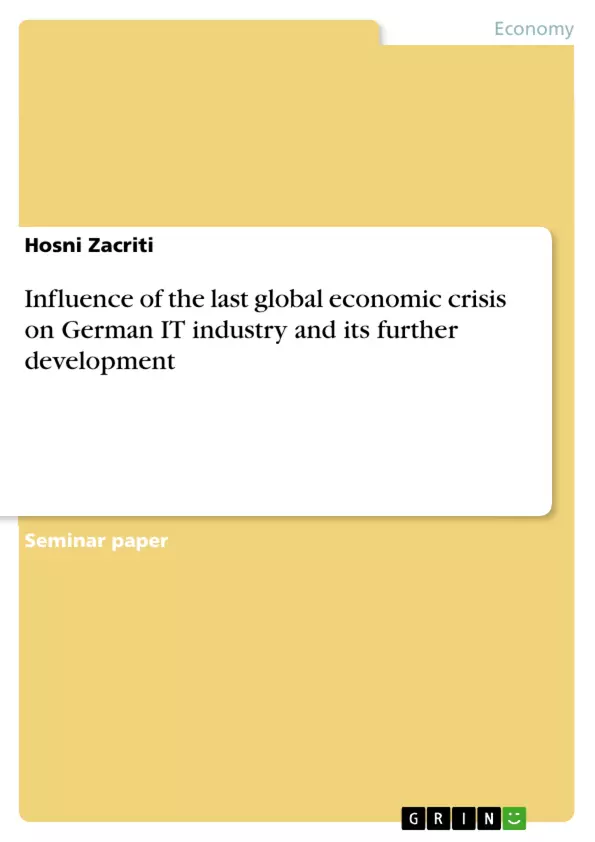This elaboration deals with the issue of the previous recession.
After a detailed definition of the business cycles, their prediction and significance in the economic area, the emphasis was placed on the German information technology industry and examined. The global economic crisis had a significant impact on exports and investment-based industries. In contrast to other industries, this sector was able to recover relatively quickly from the market breaks. By using the Diamond Porter analysis, it was found that this was also due to the economic situation in Germany, thus highlighting Competitive advantages over other economic areas in the regeneration of market shares.
Inhaltsverzeichnis (Table of Contents)
- List of Figures
- List of Tables
- 1 Introduction
- 1.1 Economic crisis
- 1.2 Business context
- 1.3 Purpose of Research
- 2 Review of current thinking and Definitions
- 2.1 Business Cycle
- 2.2 Business Cycle indicators
- 2.3 Recession
- 3 Global Financial crisis
- 3.1 Influence on the German information technology sector
- 3.2 Crisis behaviour of the German information technology sector
- 4 Market situation after the crisis
- 4.1 IT competitive situation with Porter Diamond Model in Germany IT Industry
- 4.2 Demand Conditions
- 4.3 Factor Conditions
- 4.4 Firm, Strategy, Structure and Rivalry
- 4.5 Government
- 4.6 Chance
- 4.7 Related and Supported Industry
- 5 Data Analysis and Interpretation
- 6 Conclusion
- Bibliography
Zielsetzung und Themenschwerpunkte (Objectives and Key Themes)
This study focuses on analyzing the impact of the global economic crisis on the German information technology (IT) sector, aiming to understand its resilience and recovery. The focus is on the German IT industry's competitiveness in the global market and its recovery from the crisis, including the factors that contributed to its success.
- The impact of the global economic crisis on various industries.
- The performance of the German IT sector during the crisis.
- The role of competitive advantages in the German IT industry's recovery.
- Analysis of the German IT sector using the Diamond Porter model.
- Policy measures supporting the IT sector in Germany.
Zusammenfassung der Kapitel (Chapter Summaries)
- Chapter 1: Introduction This chapter introduces the global economic crisis and its impact on industries. It sets the context by outlining the focus on the German IT sector and the study's objectives.
- Chapter 2: Review of current thinking and Definitions This chapter provides definitions and explores relevant concepts like business cycles, business cycle indicators, and recessions, setting a theoretical foundation for the analysis.
- Chapter 3: Global Financial crisis This chapter delves into the influence of the global financial crisis on the German IT sector, examining its impact and the sector's response to the crisis.
- Chapter 4: Market situation after the crisis This chapter examines the market situation in the German IT sector after the crisis, using the Diamond Porter model to analyze its competitive advantage and the factors contributing to its recovery.
- Chapter 5: Data Analysis and Interpretation This chapter presents and analyzes data related to the German IT sector's performance and the factors influencing its recovery.
Schlüsselwörter (Keywords)
The key terms and concepts explored in this study include global economic crisis, German information technology (IT) sector, competitive advantage, Diamond Porter model, business cycle, recession, global competitiveness, and economic recovery. The study focuses on analyzing the impact of the crisis on the IT sector, examining its resilience and the factors that contributed to its successful recovery.
- Arbeit zitieren
- Hosni Zacriti (Autor:in), 2017, Influence of the last global economic crisis on German IT industry and its further development, München, GRIN Verlag, https://www.grin.com/document/383593



